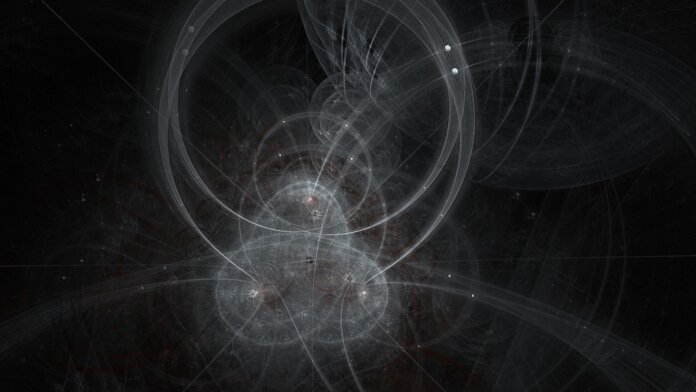Just over a week ago, European physicists announced they had measured the strength of gravity on the smallest scale ever.
In a clever tabletop experiment, researchers at Leiden University in the Netherlands, the University of Southampton in the UK, and the Institute for Photonics and Nanotechnologies in Italy measured a force of around 30 attonewtons on a particle with just under half a milligram of mass. An attonewton is a billionth of a billionth of a newton, the standard unit of force.
The researchers say the work could “unlock more secrets about the universe’s very fabric” and may be an important step toward the next big revolution in physics.
But why is that? It’s not just the result: it’s the method, and what it says about a path forward for a branch of science critics say may be trapped in a loop of rising costs and diminishing returns.
Gravity
From a physicist’s point of view, gravity is an extremely weak force. This might seem like an odd thing to say. It doesn’t feel weak when you’re trying to get out of bed in the morning!
Still, compared with the other forces that we know about—such as the electromagnetic force that is responsible for binding atoms together and for generating light, and the strong nuclear force that binds the cores of atoms—gravity exerts a relatively weak attraction between objects.
And on smaller scales, the effects of gravity get weaker and weaker.
It’s easy to see the effects of gravity for objects the size of a star or planet, but it is much harder to detect gravitational effects for small, light objects.
The Need to Test Gravity
Despite the difficulty, physicists really want to test gravity at small scales. This is because it could help resolve a century-old mystery in current physics.
Physics is dominated by two extremely successful theories.
The first is general relativity, which describes gravity and spacetime at large scales. The second is quantum mechanics, which is a theory of particles and fields—the basic building blocks of matter—at small scales.
These two theories are in some ways contradictory, and physicists don’t understand what happens in situations where both should apply. One goal of modern physics is to combine general relativity and quantum mechanics into a theory of “quantum gravity.”
One example of a situation where quantum gravity is needed is to fully understand black holes. These are predicted by general relativity—and we have observed huge ones in space—but tiny black holes may also arise at the quantum scale.
At present, however, we don’t know how to bring general relativity and quantum mechanics together to give an account of how gravity, and thus black holes, work in the quantum realm.
New Theories and New Data
A number of approaches to a potential theory of quantum gravity have been developed, including string theory, loop quantum gravity, and causal set theory.
However, these approaches are entirely theoretical. We currently don’t have any way to test them via experiments.
To empirically test these theories, we’d need a way to measure gravity at very small scales where quantum effects dominate.
Until recently, performing such tests was out of reach. It seemed we would need very large pieces of equipment: even bigger than the world’s largest particle accelerator, the Large Hadron Collider, which sends high-energy particles zooming around a 27-kilometer loop before smashing them together.
Tabletop Experiments
This is why the recent small-scale measurement of gravity is so important.
The experiment conducted jointly between the Netherlands and the UK is a “tabletop” experiment. It didn’t require massive machinery.
The experiment works by floating a particle in a magnetic field and then swinging a weight past it to see how it “wiggles” in response.
This is analogous to the way one planet “wiggles” when it swings past another.
By levitating the particle with magnets, it can be isolated from many of the influences that make detecting weak gravitational influences so hard.
The beauty of tabletop experiments like this is they don’t cost billions of dollars, which removes one of the main barriers to conducting small-scale gravity experiments, and potentially to making progress in physics. (The latest proposal for a bigger successor to the Large Hadron Collider would cost $17 billion.)
Work to Do
Tabletop experiments are very promising, but there is still work to do.
The recent experiment comes close to the quantum domain, but doesn’t quite get there. The masses and forces involved will need to be even smaller to find out how gravity acts at this scale.
We also need to be prepared for the possibility that it may not be possible to push tabletop experiments this far.
There may yet be some technological limitation that prevents us from conducting experiments of gravity at quantum scales, pushing us back toward building bigger colliders.
Back to the Theories
It’s also worth noting some of the theories of quantum gravity that might be tested using tabletop experiments are very radical.
Some theories, such as loop quantum gravity, suggest space and time may disappear at very small scales or high energies. If that’s right, it may not be possible to carry out experiments at these scales.
After all, experiments as we know them are the kinds of things that happen at a particular place, across a particular interval of time. If theories like this are correct, we may need to rethink the very nature of experimentation so we can make sense of it in situations where space and time are absent.
On the other hand, the very fact we can perform straightforward experiments involving gravity at small scales may suggest that space and time are present after all.
Which will prove true? The best way to find out is to keep going with tabletop experiments, and to push them as far as they can go.
This article is republished from The Conversation under a Creative Commons license. Read the original article.
Image Credit: Garik Barseghyan / Pixabay



